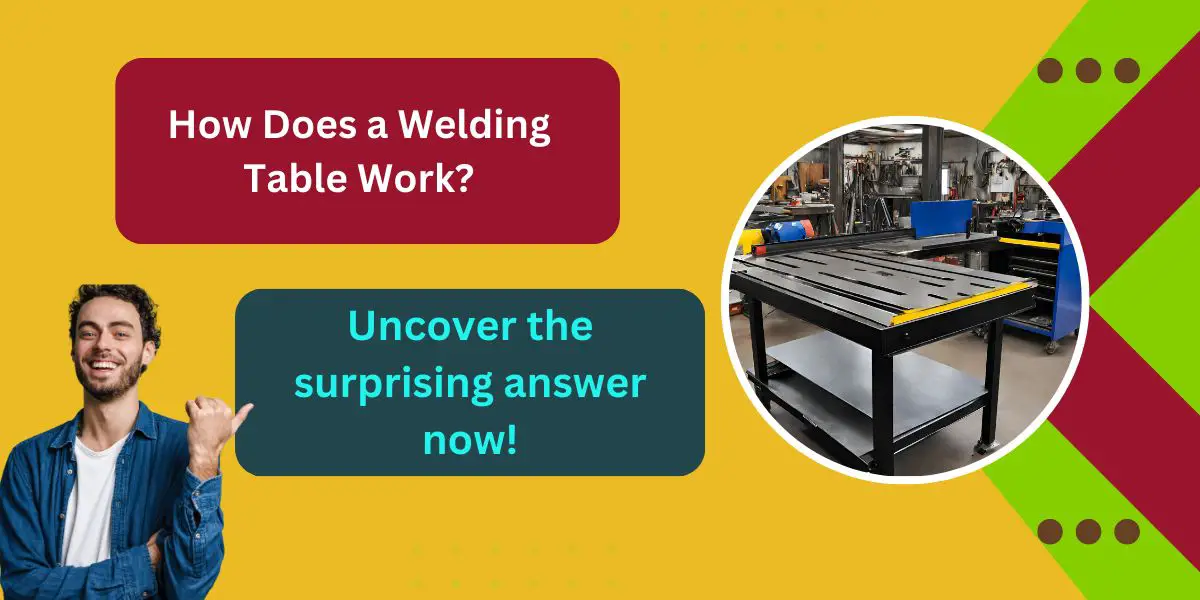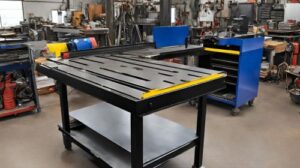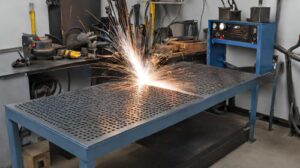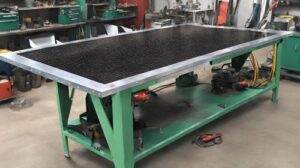Table of Contents
- What is a Welding Table?
- Types of Welding Tables
- Features of a Welding Table
- How Does a Welding Table Work?
- Advantages of Using a Welding Table
- What is the Point of a Welding Table?
- Can You Touch a Welding Table While Welding?
- Do You Need a Metal Welding Table to Weld?
- What are the Holes for in a Welding Table?
- Conclusion
In metal fabrication and welding, a welding table is an indispensable tool crucial in ensuring precise and efficient welding processes. Whether you are a seasoned welder or a DIY enthusiast looking to explore welding projects, understanding how a welding table works is essential.
This article will delve into the mechanics of a welding table, its features, and its benefits.
What is a Welding Table?
A welding table is a specialized work surface designed to provide a stable and secure platform for welding operations. It is typically made of thick, durable steel, known for its heat resistance and sturdiness. The surface of the welding table is often smooth, allowing for easy clean-up and preventing slag or spatter from sticking to it.
Types of Welding Tables
Various types of welding tables are available in the market, catering to different welding needs. Some common types include:
Fixed Welding Tables
Fixed welding tables are sturdy and permanently set in place, making them ideal for heavy-duty welding projects. They offer exceptional stability, ensuring precise and accurate welds.
Adjustable Welding Tables
As the name suggests, adjustable welding tables come with height and angle adjustability. Welders can customize the table’s position to suit their comfort and specific welding requirements.
Portable Welding Tables
Portable welding tables are lightweight and designed for welders who need to move their workspace frequently. They are convenient for on-site jobs and smaller welding projects.
Features of a Welding Table
A well-designed welding table boasts various features that enhance its functionality and efficiency:
Heat Resistance
Welding tables are constructed with materials that can withstand high temperatures without warping or compromising their structural integrity.
Clamping Systems
Welding tables often come equipped with built-in clamping systems or fixtures. These allow welders to securely hold the workpiece in place during welding, ensuring accuracy.
Grid Patterns
Many welding tables have grid patterns on their surface. These grids help in aligning and measuring workpieces accurately, ensuring precise welds.
Debris Collection Tray
To maintain a clean working environment, some welding tables have debris collection trays that catch stray sparks, slag, and other debris during the welding process.
How Does a Welding Table Work?
A welding table operates on a straightforward principle of providing a stable, flat surface for welding tasks. When setting up a welding table for a project, follow these steps:
Leveling the Table
Before starting any welding work, ensure the table is level to prevent any distortion or irregularities in the welds.
Securing the Workpiece
Use the clamping system or fixtures on the welding table to secure the workpiece firmly. This prevents any movement during welding, leading to cleaner and more accurate welds.
Ensuring Proper Ventilation
Proper ventilation is crucial in enclosed spaces to dissipate welding fumes and gases. Adequate ventilation protects the welder’s health and ensures a safer working environment.
Using Protective Gear
Welding produces intense heat, bright light, and sparks. Welders must wear appropriate protective gear, such as welding helmets, gloves, and clothing, to safeguard themselves from potential hazards.
Advantages of Using a Welding Table
Investing in a quality welding table offers several advantages:
Enhanced Precision
The stability and flatness of a welding table enable precise welding, leading to better weld quality and aesthetics.
Time Efficiency
With a secure workpiece and organized setup, welders can complete projects more efficiently, reducing welding time.
Safety and Cleanliness
Welding tables with debris collection trays promotes a clean and safe working environment by minimizing stray sparks and slag.
Flexibility
Adjustable welding tables allow welders to work comfortably and customize their work angle, enhancing flexibility in welding tasks.
What is the Point of a Welding Table?
A welding table is a dedicated and reliable work surface for welding operations. Its primary purpose is to provide a stable and flat platform for welding tasks.
When welding on a regular surface, such as a workbench, the heat and spatter generated during welding can cause damage and compromise the integrity of the work surface.
A welding table made of durable and heat-resistant materials like steel prevents these issues, ensuring precise and accurate welds.
Can You Touch a Welding Table While Welding?
No, it is essential to avoid touching a welding table while welding. During the welding process, the table becomes extremely hot, and direct contact with the table can cause burns and injuries.
Welders must always use appropriate clamping systems or fixtures to secure the workpiece and maintain a safe distance from the welding table during the welding operation.
Do You Need a Metal Welding Table to Weld?
While a metal welding table is preferred for welding tasks due to its heat resistance and stability, it is not an absolute requirement. Some welders may opt for other materials like ceramic or stone surfaces for specialized welding applications.
However, using a metal welding table offers numerous advantages, such as excellent heat dissipation, easy cleaning, and enhanced precision.
What are the Holes for in a Welding Table?
One of the distinctive features of a welding table is the presence of holes or slots on its surface. These holes serve multiple purposes:
Clamping and Fixturing
Welding tables often have a grid pattern of holes, allowing for various clamping and fixturing options. Welders can use clamps and fixtures to secure the workpiece firmly, ensuring stability during welding and precise alignment.
Tool Placement and Accessories
The holes on a welding table also facilitate the placement of welding tools and accessories. Welding clamps, angle grinders, and other tools can be conveniently within reach, optimizing workflow and productivity.
Debris Collection
During the welding process, welding debris is generated, such as spatter and slag. The holes in the welding table allow this debris to fall through, keeping the work surface cleaner and reducing the risk of weld defects caused by debris interference.
Jigs and Templates
Welding tables with a pattern of holes enable using jigs and templates, which are essential for repetitive welding tasks. Jigs and templates help maintain consistency and accuracy in weld placement and alignment.
Conclusion
A welding table is an indispensable tool for welders, offering stability, precision, and safety during welding operations. Understanding its features and benefits can significantly enhance welding projects’ outcomes.
So, whether you’re a professional welder or an enthusiastic DIYer, investing in a quality welding table is a decision that will undoubtedly improve your welding experience.
FAQs
What are the main parts of a welding table, and how do they work?
The main parts of a welding table typically include the tabletop, legs, and often additional accessories like clamps and tool holders. The tabletop provides a stable surface for welding, while the legs support the table’s weight and provide stability.
Can a welding table handle different welding techniques?
Yes, a welding table accommodates techniques such as MIG, TIG, stick welding, and more. Its flat and sturdy surface allows for precise welding work regardless of the technique used.
What features should I consider when buying a welding table?
When purchasing a welding table, consider factors such as the material of the tabletop (usually steel), the size and weight capacity of the table, the presence of adjustable features like height or angle, and any additional accessories included with the table.
How do I clean and maintain my welding table?
To clean and maintain a welding table, regularly remove slag, spatter, and debris from the tabletop using a wire brush or scraper. Wipe down the surface with a clean cloth and a mild solvent to remove grease or oil buildup. Lubricate moving parts as needed and inspect for any signs of damage or wear.
What upgrades can I make to improve my welding table’s performance?
Standard upgrades for welding tables include adding wheels for mobility, installing a grid pattern or slots for easier clamping, attaching vices or additional tool holders for convenience, and reinforcing the table structure for increased stability and durability.



